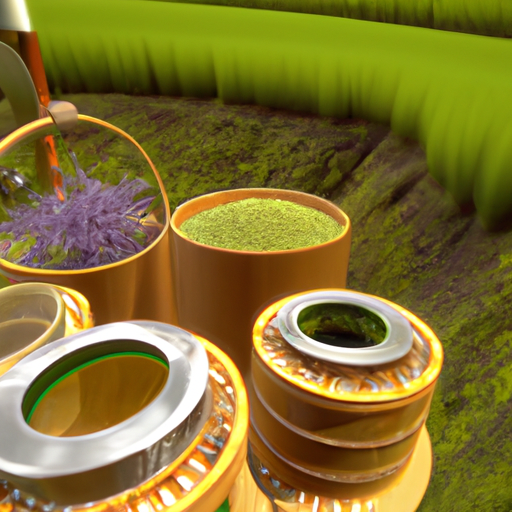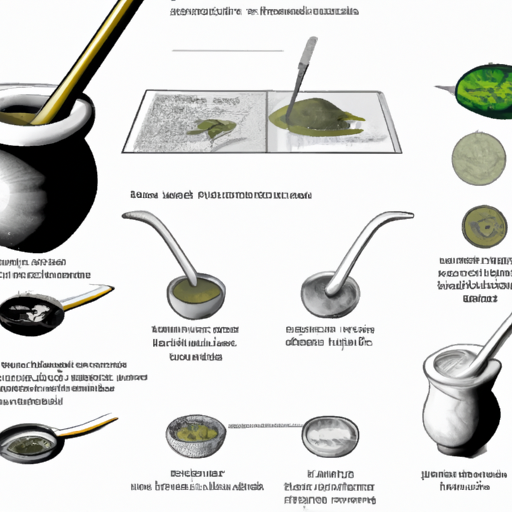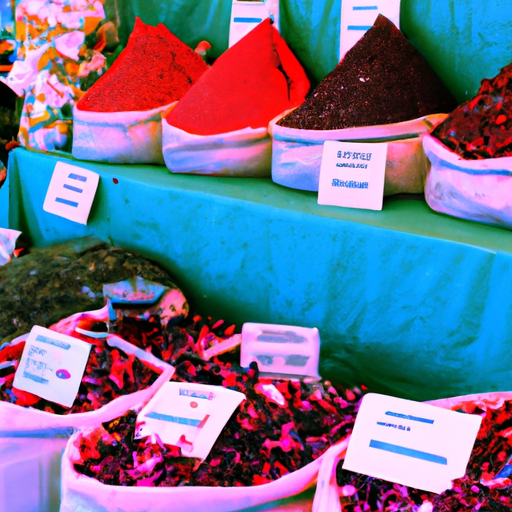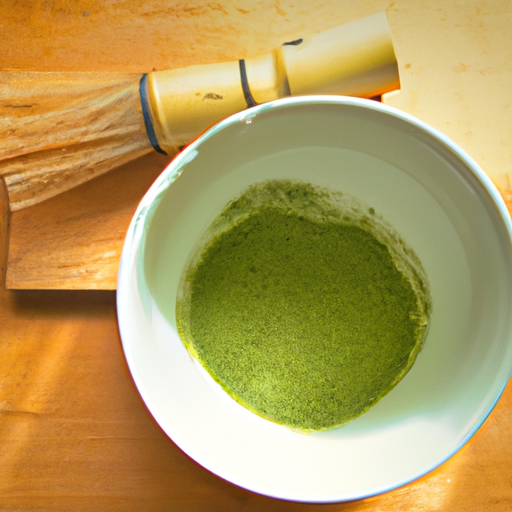While enjoying a gulp of my creamy matcha latte, my curiosity piques about the roots of this vivid green substance. Matcha has gained international popularity as a beverage, but what is its true place of origin?
The answer lies in the lush green tea fields of Japan, where the art of cultivating and processing matcha has been perfected over centuries. Matcha is not just any tea – it is a symbol of Japanese culture, tradition, and excellence.
The process of producing matcha is a delicate and meticulous one, involving shade-grown tea leaves, stone grinding, and careful attention to detail. In this article, we will delve into the history and production of matcha, explore its health benefits and culinary uses, and discover the different varieties of matcha that exist.
So sit back, relax, and join me on a journey to uncover the secrets of matcha.
Key Takeaways
- Matcha originates from Japan and is a symbol of Japanese culture, tradition, and excellence.
- Matcha production involves shade-grown tea leaves, stone grinding, and attention to detail.
- Drinking matcha has numerous health benefits, including high levels of antioxidants and natural caffeine.
- There is a push for more ethical and sustainable production methods in the matcha industry to reduce its impact on the environment and ensure fair treatment of farmers and workers.
Origins of Matcha
Matcha has always fascinated me, especially its origins.
The historical background of matcha is quite interesting. It is said that matcha was first introduced during the Tang Dynasty in China, and it was brought to Japan by the Zen monk Eisai in the late 12th century.
The traditional Japanese tea ceremony, which is an integral part of Japanese culture, is often associated with matcha and has played a significant role in the popularity of this powdered tea.
Historical Background
You might be interested to know that centuries ago, the Japanese perfected a method of grinding tea leaves into a fine powder, which eventually led to the creation of matcha as we know it today. The cultural significance of matcha in Japan cannot be understated, as it has been an integral part of Japanese tea culture for centuries. Matcha’s influence on tea culture also extends beyond Japan, with its popularity spreading to other parts of the world in recent years.
To better understand the history of matcha, it is helpful to look at the table below, which outlines some key events and figures in the development of matcha. From the Tang dynasty in China to the Zen monks in Japan, matcha has a rich and storied history that has been shaped by many different cultures and individuals. As a lover of matcha myself, I find it fascinating to learn about the origins and evolution of this beloved drink.
| Time Period | Event/Figure |
|---|---|
| Tang Dynasty (618-907) | Tea leaves are ground into powder in China |
| Song Dynasty (960-1279) | Whisking tea becomes a popular practice in China |
| Zen Monks (12th-13th century) | Matcha is introduced to Japan by Zen monks |
| Rikyu (1522-1591) | Introduction of the tea ceremony and development of the wabi-cha style |
| 20th Century | Matcha becomes popular worldwide, used in various food and beverage products |
With a rich history that spans centuries, matcha has become a beloved beverage and cultural icon across the world. The traditional Japanese tea ceremony, which incorporates matcha, is an important part of Japanese culture that has been passed down through generations. Let’s dive deeper into the intricacies and beauty of the tea ceremony in the next section.
Traditional Japanese Tea Ceremony
Immerse yourself in the alluring tradition of the Japanese tea ceremony, where every gesture and detail is carefully crafted to create a serene experience.
The Japanese tea ceremony, also known as the Way of Tea or Chado, is a cultural practice that dates back to the 12th century. It involves the preparation and presentation of matcha, a finely ground green tea that is whisked with hot water to create a frothy, vibrant green drink.
The ceremony is steeped in symbolism and ritual, with every movement and gesture imbued with meaning. Tea utensils play a crucial role in the ceremony, each one carefully chosen and placed in a specific location.
Etiquette is also an essential component, with guests expected to observe certain customs and manners. For example, before entering the tea room, guests must purify themselves with a small basin of water.
As we delve deeper into the production process, it’s fascinating to see how the tea leaves are grown, harvested, and processed to create the matcha powder that’s used in the ceremony.
The Production Process
During the production process, the leaves are carefully shade-grown and stone-ground, resulting in a delicate and flavorful powder that is truly unique. Matcha farming requires a lot of patience and attention to detail. The tea plants are covered with bamboo mats or straw shades for several weeks before harvesting to shield them from direct sunlight. This process increases the chlorophyll levels in the leaves, giving matcha its distinctive green color.
After harvesting, the stems and veins are removed from the leaves, leaving only the finest parts. These are then ground into a fine powder using traditional stone grinding techniques. It can take up to an hour to grind just 30 grams of matcha, as the process requires patience and skill. The resulting powder is then packaged and ready to be enjoyed.
Drinking matcha has numerous health benefits, including high levels of antioxidants and natural caffeine. It is also said to boost energy, improve mental clarity, and aid in weight loss. With its unique production process and health benefits, it’s no wonder matcha has become increasingly popular in recent years.
Health Benefits of Drinking Matcha
The health benefits of drinking matcha are numerous and impressive. One study found that regular consumption can lower the risk of heart disease by up to 31%. Matcha is packed with antioxidants, which help protect the body against damage from free radicals. These antioxidants also contribute to the prevention of chronic diseases such as cancer and type 2 diabetes.
In addition, matcha has been shown to aid in weight loss. The catechins in matcha tea can help boost metabolism and increase fat burning. Matcha also promotes feelings of fullness, which can help reduce overall calorie intake. For those looking to lose weight, incorporating matcha into their diet can be a helpful tool.
If you’re looking to incorporate matcha into your diet, there are many delicious recipes to try. Matcha lattes, smoothies, and even ice cream can be made with this versatile ingredient. In the next section, we’ll explore the culinary uses of matcha in more detail.
Culinary Uses of Matcha
You can explore new flavors and add a healthy twist to your favorite recipes by incorporating matcha into your cooking. Matcha is a versatile ingredient that can be used to make a variety of sweet and savory dishes.
Here are some ways you can use matcha in your culinary creations:
-
Matcha desserts: You can use matcha powder to make delicious desserts like matcha ice cream, matcha cheesecake, and matcha cupcakes. The green color of matcha adds a unique touch to these desserts, and the natural sweetness of matcha powder makes them healthier than traditional desserts that use refined sugar.
-
Savory matcha recipes: Matcha is not just limited to sweet dishes; it can also be used in savory recipes. You can add matcha powder to soups, sauces, and marinades to give them a unique flavor. Matcha can also be used as a rub for chicken, fish, or tofu to create a savory dish with a hint of green tea flavor.
Incorporating matcha into your cooking not only adds a unique flavor to your dishes, but it also provides numerous health benefits. Matcha is rich in antioxidants, vitamins, and minerals. It boosts metabolism, enhances brain function, and reduces the risk of chronic diseases.
To prepare matcha for culinary use, you need to sift the matcha powder to remove any lumps. You can then mix the powder with other ingredients to create a batter or dough. Alternatively, you can sprinkle matcha powder on top of your dishes as a garnish.
With these tips, you can explore the endless possibilities of matcha in your cooking.
How to Prepare Matcha
Get ready to experience the soothing aroma and vibrant green color of freshly prepared matcha by following these easy steps. Matcha is a delicate and flavorful tea that requires special preparation. To start, gather your matcha accessories: a bamboo whisk, a tea bowl, and a tea scoop.
Next, sift 1-2 teaspoons of matcha powder into the tea bowl to remove any lumps. Add hot water (not boiling) to the bowl, and whisk the matcha with the bamboo whisk in a zigzag motion until it becomes frothy. This preparation method, called usucha, produces a thinner and lighter tea, perfect for everyday consumption.
For those looking to explore matcha recipes beyond traditional tea preparation, try adding matcha to smoothies, baked goods, or even savory dishes. Matcha’s unique flavor and vibrant color make it a versatile ingredient in both sweet and savory dishes. Experiment with different recipes to find your favorite way to enjoy matcha.
As we move on to discuss the different varieties of matcha, keep in mind that the preparation method and quality of matcha used can greatly affect the flavor and overall experience.
Varieties of Matcha
Now that we know how to prepare matcha, let’s delve deeper into the world of matcha and explore its different varieties. Matcha comes in different grades, each with its unique flavor profile. The grades are determined by the quality of the tea leaves, the cultivation process, and the production method.
The highest grade of matcha is called ceremonial grade. It’s made from the youngest tea leaves, which are hand-picked and stone-ground into a fine powder. Ceremonial grade matcha has a delicate flavor profile, with a smooth and sweet taste, and a vibrant green color. This grade of matcha is usually used in traditional tea ceremonies, where it is served in small bowls and sipped slowly.
On the other hand, culinary grade matcha is made from older tea leaves, which are machine-harvested and ground into a coarser powder. This grade of matcha has a stronger flavor profile and is often used in cooking and baking. It’s also a more affordable option for those who want to enjoy matcha regularly without breaking the bank.
As matcha continues to gain popularity worldwide, it’s essential to understand the different grades and flavor profiles. Whether you’re looking for a delicate and sweet taste or a bolder flavor to incorporate into your recipes, there’s a matcha grade that will suit your needs.
So, let’s explore the global popularity of matcha and how it’s become a staple in many cultures.
Global Popularity of Matcha
With its unique flavor and vibrant green color, matcha has become a popular beverage and ingredient globally. The rise of social media has contributed greatly to its popularity, with matcha lattes and desserts flooding Instagram feeds. People are drawn to the aesthetic appeal of matcha, not only for its color but also for the cultural identity it represents.
Matcha is deeply rooted in Japanese culture and has been used in traditional tea ceremonies for centuries. The popularity of matcha has allowed people to connect with Japanese culture and appreciate its traditions.
Matcha’s global popularity has also raised concerns about sustainability and ethics. The high demand for matcha has led to unsustainable farming practices and exploitation of workers. Consumers are becoming more conscious of the impact their choices have on the environment and the people involved in the production process.
As a result, there has been a push for more ethical and sustainable production methods. It is important for consumers to be informed about the products they consume and to support companies that prioritize sustainability and ethics.
Matcha’s popularity has transcended cultural boundaries and has become a global phenomenon. Social media has played a significant role in its rise to fame, but it is important to recognize the cultural significance behind it. The demand for matcha has also highlighted the need for sustainable and ethical production methods.
As consumers, we have the power to make informed choices and support companies that prioritize sustainability and ethics.
Sustainability and Ethics
You can make a difference in the world by supporting companies that prioritize sustainable and ethical production methods, ensuring that your consumption of matcha aligns with your values and contributes to a better future for all.
Matcha production can have a significant impact on the environment, from deforestation to pollution. By choosing matcha that is ethically sourced and produced through fair trade practices, you can ensure that the farmers and workers involved are treated fairly and that the production methods are sustainable.
Here are three ways you can support sustainable and ethical matcha production:
-
Look for certifications such as Fair Trade and Rainforest Alliance to ensure that the matcha you are purchasing has been produced in an ethical and environmentally conscious manner. These certifications guarantee that the farmers are paid fairly and that the production methods are sustainable, reducing the carbon footprint of the matcha industry.
-
Choose matcha from companies that prioritize sustainability and ethical production methods. Many companies are now taking steps to reduce their carbon footprint, such as using renewable energy sources and implementing waste reduction strategies. By supporting these companies, you’re contributing to a more sustainable future.
-
Reduce your own carbon footprint by purchasing matcha that’s locally sourced. This not only supports local businesses and reduces transportation emissions but also ensures that the matcha you’re consuming is fresh and of high quality.
By making conscious choices when it comes to matcha consumption, we can contribute to a more sustainable and ethical future for all. Let’s support companies that prioritize fair trade and sustainability and make a positive impact on the environment and the lives of those involved in matcha production.
Frequently Asked Questions
What is the difference between matcha and regular green tea?
As someone who’s been a tea enthusiast for years, I can confidently say that there’s a significant difference between matcha and regular green tea.
While both come from the same plant, matcha is produced differently and has a unique taste and texture.
Matcha is made by grinding whole green tea leaves into a fine powder, while regular green tea is made by steeping tea leaves in water.
This means that when you drink matcha, you’re consuming the whole tea leaf, which is why it has more health benefits than regular green tea.
Matcha is known for its high concentration of antioxidants, which help promote overall health and prevent chronic diseases.
Additionally, matcha has a higher caffeine content than regular green tea, providing a natural energy boost.
As for preparation techniques, matcha is traditionally whisked with hot water using a bamboo whisk until it becomes frothy.
This process creates a unique, creamy texture that is different from regular green tea.
Overall, matcha is a delicious and healthy alternative to regular green tea, and its unique preparation and taste make it a favorite among tea lovers.
Can matcha be grown outside of Japan?
Yes, matcha can be grown outside of Japan. However, it’s important to note that matcha cultivation and production methods greatly impact the quality and taste of the final product.
Matcha requires specific growing conditions such as shaded areas and careful harvesting techniques in order to develop its distinct flavor and nutrient-rich properties.
While matcha is traditionally associated with Japan, there are now matcha producers in other countries such as China and Korea who are creating their own unique versions of the tea.
Nonetheless, it’s important for consumers to be aware of the production methods used by these producers in order to ensure the quality and authenticity of the matcha they’re purchasing.
How long does matcha stay fresh after it’s been opened?
So, how long does matcha stay fresh after it’s been opened?
The shelf life of matcha can vary depending on how it is stored. If kept in an airtight container in a cool, dry place, matcha can last up to six months after opening. However, if not stored properly, the matcha can quickly lose its flavor and become stale.
It’s important to avoid exposure to air, light, and moisture, as these factors can accelerate oxidation and lead to flavor changes. To extend the shelf life of matcha, it’s best to store it in the refrigerator or freezer. Additionally, it’s recommended to use the matcha within one month of opening to ensure optimal freshness and flavor.
Is matcha safe for pregnant or breastfeeding women to consume?
As a virtual assistant, I’m not qualified to provide medical advice. However, I can tell you that matcha is a type of green tea that’s high in antioxidants and has been shown to have numerous health benefits. Matcha nutrition includes vitamins, minerals, and amino acids that can support overall health.
However, matcha also contains caffeine, which can have both benefits and drawbacks for pregnant and breastfeeding women. While moderate caffeine intake is generally considered safe during pregnancy and nursing, it’s important to consult with a healthcare provider to determine what’s best for you and your baby.
There are also many creative ways to enjoy matcha during pregnancy and nursing, such as incorporating it into smoothies, baked goods, and other recipes.
Are there any potential side effects of drinking matcha in excess?
As someone who incorporates matcha into my daily routine, I can attest to its numerous health benefits. However, it’s important to note that like any other food or beverage, consuming matcha in excess can have potential side effects.
Matcha contains caffeine, so consuming too much of it can lead to jitters, anxiety, and trouble sleeping. Additionally, while matcha has been linked to weight loss, relying solely on it as a weight loss tool can be detrimental to overall health.
It’s always important to consume matcha in moderation and as part of a balanced diet.
Conclusion
Well, there you have it, folks: the fascinating origins of matcha and how it’s become a global sensation. Matcha has a rich history that’s been appreciated for centuries, from its humble beginnings in China to its refined production process in Japan. The health benefits of drinking matcha are undeniable, and its versatility in culinary applications is unmatched.
As I sip on my freshly whisked matcha, I’m reminded of the famous quote by Maya Angelou: "I’ve learned that people will forget what you said, people will forget what you did, but people will never forget how you made them feel."Matcha has a way of making me feel grounded, energized, and calm all at the same time. Its unique flavor and vibrant green color are a testament to its purity and quality.
One can only hope that the sustainability and ethics surrounding matcha production continue to be upheld, so that future generations can enjoy this wonderful beverage.










